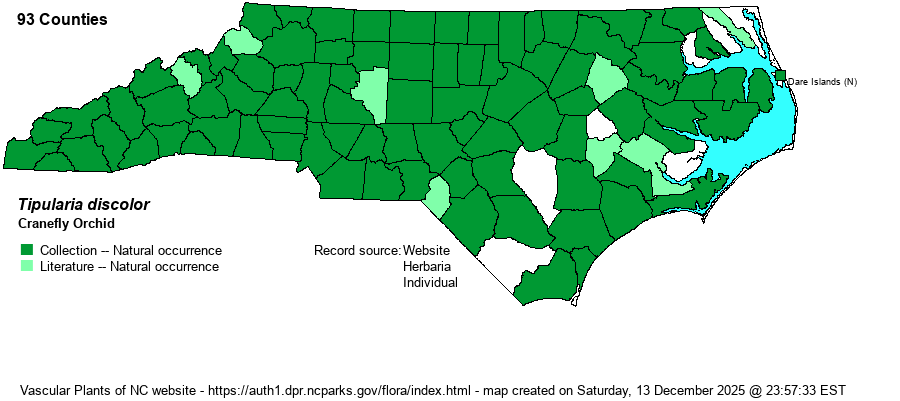| Author | (Pursh) Nuttall | |
| Distribution | Occurs statewide, and presumably occurs in all 100 counties, though the map below is lacking 10 counties.
Ranges from southeastern MA to southwestern MI south and west to north FL, MO, and eastern TX. | |
| Abundance | Common to very common across the Mountains and Piedmont. Generally common in the Coastal Plain, though there are numerous counties there without a known record. This is the most numerous and frequently seen orchid in the state. | |
| Habitat | This species has a great variety of forested habitats, and because it favors acidic soils, it has an abundance of available sites for growing in every county. It occurs more often in upland hardwood and mixed forests, but it does occur in bottomland forests as well. It also can occur in some pine forests, as well, though it does not generally occur in sandy soils such as in upland Longleaf Pine sites. |
| Phenology | Blooms in late summer, generally from July into September, and it fruits shortly after blooming. However, after fruiting a basal leaf appears and it remains over the winter and until just before blooming in midsummer. Thus, some parts are above ground nearly all year. | |
| Identification | Though the stem and flowers are purplish-brown and can easily blend into the background and become almost invisible unless one looks closely, because it is so numerous an observer should be able to find the species on many or most forest walks. In the cooler months, the single basal leaf grows flat or nearly flat on the ground; it is green above but bright purple below, rendering it easy to identify if you flip the leaf over! Each leaf is elliptical to ovate, entire, and about 2-3 inches long; a number of plants often grow together, so one often sees a handful of leaves in a small area. The flowering stem is naked and grows about 10-20 inches tall, topped by a loose raceme of several dozen "watery purple-brown to greenish-brown" flowers. As the flower parts are quite narrow, the visual effect of a flower is the appearance of a crane fly or a spider. In fall, the many drooping buffy-brown capsules may catch the eye more readily than the flower cluster. The only species anywhere close to Tipularia is Aplectrum hyemale, which may grow in the same upland forests; that species has a much larger basal leaf, also purple below but above it has alternating narrow stripes of white and green; the capsules are similar but larger. It flowers in May (mostly), and the flowers are quite different. | |
| Taxonomic Comments | None
| |
| Other Common Name(s) | Crippled Cranefly | |
| State Rank | S5 | |
| Global Rank | G4G5 [G5] | |
| State Status | | |
| US Status | | |
| USACE-agcp | FACU link |
| USACE-emp | FACU link |

